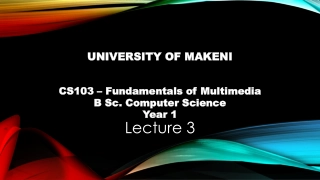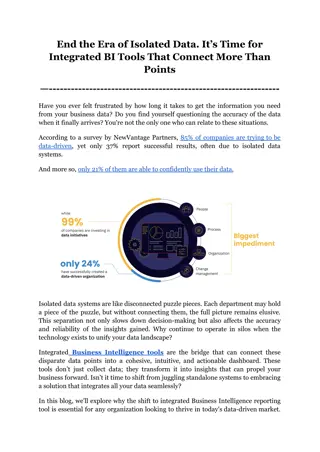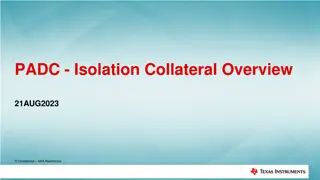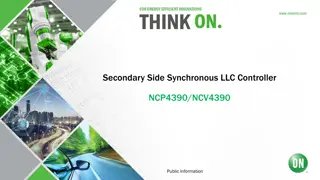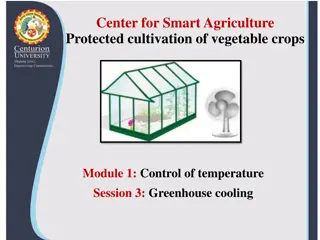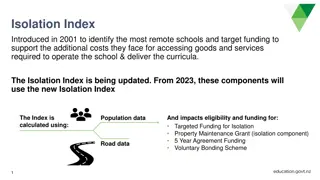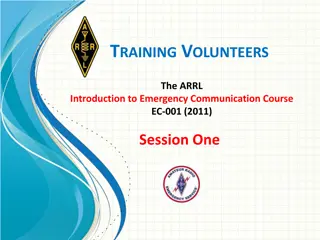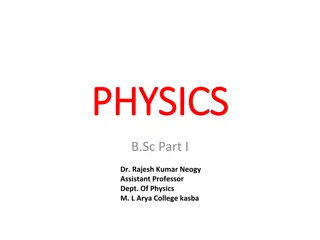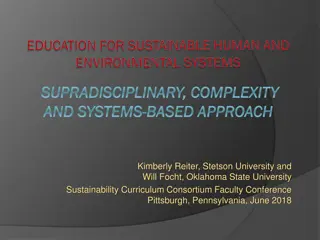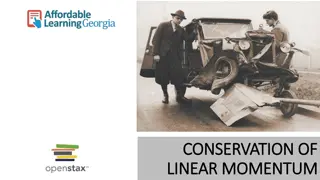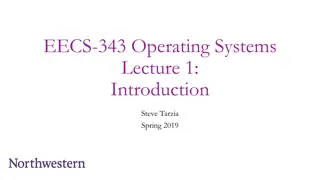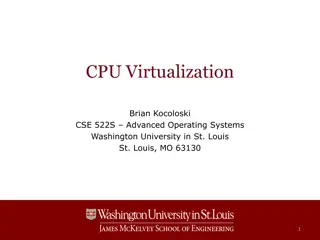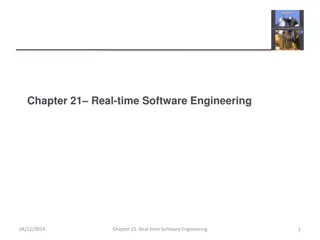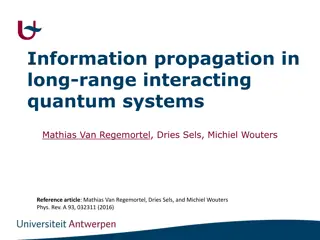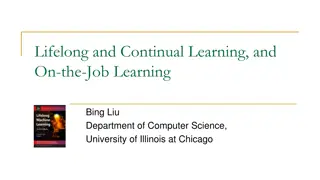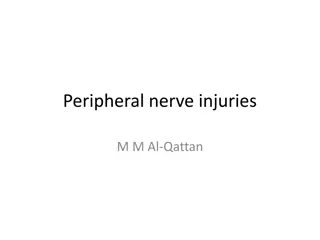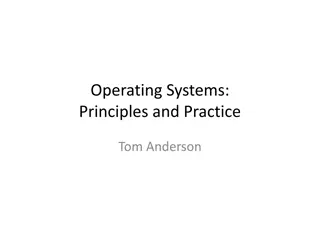Understanding Multimedia Systems: Hardware and Software Components
Multimedia systems require specific hardware and software components to meet the demands of producing and playing multimedia content. Development systems are used for creating content with higher specifications, while playback systems are used for playing multimedia files with lower specifications.
8 views • 46 slides
Embedded Systems Design Process in the Embedded systems
Embedded systems are all around us, from the tiny microcontrollers in our household appliances to the sophisticated control systems in cars and aeroplanes. But how are these systems designed? Let's delve into the basics of the embedded systems design process in simple terms that anyone can understan
2 views • 9 slides
Overview of Distributed Systems: Characteristics, Classification, Computation, Communication, and Fault Models
Characterizing Distributed Systems: Multiple autonomous computers with CPUs, memory, storage, and I/O paths, interconnected geographically, shared state, global invariants. Classifying Distributed Systems: Based on synchrony, communication medium, fault models like crash and Byzantine failures. Comp
9 views • 126 slides
Operating Systems
An operating system is a crucial program that manages all other programs on a computer. It handles tasks like input recognition, file management, and device control. There are different types of operating systems such as single-user, single-task systems, multi-user, multi-task systems, real-time ope
6 views • 11 slides
Understanding Information Systems in Organizational Management
Management in organizations is divided into three levels: operational, tactical, and strategic. Each level requires different information systems to support various activities. Operational systems focus on routine transactions and control processes, while middle-level systems aid in semi-structured
9 views • 39 slides
Enhancing Low Latency Channel Access in Legacy IEEE 802.11 Networks
This document discusses the impact of introducing a Low Latency (LL) channel access mechanism in legacy IEEE 802.11 networks. It addresses the use of High Priority EDCA (HiP EDCA) mechanisms, proposing solutions for improving tail latency in both isolated BSS and multi-BSS scenarios. Additionally, i
2 views • 10 slides
Understanding Trauma, Stress, and Behavior: Insights from Research on Growing Up and Promoting Self-Regulation
Explore the impact of trauma, stress, and behavior on individuals through a contextual approach based on research findings. Learn about two types of individuals exhibiting antisocial behavior, the effects of social exclusion on brain function, and the influence of racial discrimination on brain micr
3 views • 20 slides
End the Era of Isolated Data. It’s Time for Integrated BI Tools That Connect More Than Points
Explore the transformative power of integrated Business Intelligence tools in this insightful blog. We delve into the challenges posed by outdated, isolated data systems and reveal how modern Business Intelligence software solutions can unify and enhance data analysis.
1 views • 7 slides
The Impact of Social Isolation on Human Development
The findings from the study on Rhesus monkeys and case studies of isolated children like Anna, Isabelle, and Genie highlight the significant effects of social deprivation on human development. It shows that social interaction and nurturing environments are crucial for healthy psychological and emoti
0 views • 22 slides
Isolated Amplifiers and Modulators: Comprehensive Overview
This content provides a detailed overview of isolated amplifiers and modulators, highlighting their design considerations, comparing their features, discussing EMI performance best practices, and offering Excel calculators for voltage and current sensing accuracy. It covers important aspects such as
0 views • 16 slides
Understanding Atrophic Rhinitis: Causes, Symptoms, and Diagnosis
Atrophic rhinitis is a progressive chronic condition characterized by the atrophy of nasal mucosa and turbinates. It predominantly affects young to middle-aged adults, with females being more prone. Commonly isolated bacteria include Klebsiella ozaenae and others. The pathophysiology involves metapl
0 views • 12 slides
Techniques for Investigating Plant Metabolic Pathways and Biogenetic Studies
This content explores various techniques used in pharmacognosy and phytochemistry to investigate the metabolic pathways in plants and study the formation of primary and secondary metabolites. Methods such as utilizing radioactive isotopes, tracer techniques, isolated organs/tissues, grafting, and mu
4 views • 12 slides
Introduction to Database Management System Explained
This presentation covers the basics of database management systems, including definitions of data, types of data, structured and unstructured data, storing data in computers using file systems and database systems, and issues with file systems like data redundancy, inconsistency, difficult data acce
1 views • 18 slides
Understanding Types of Rural Settlements in Geography
The classification of rural settlements varies based on location and structure. Authors like August Meitzen, Ahlman, R.B. Hall, Enayat Ahmad, and R.L. Singh have identified different types of rural settlements such as nucleated villages, isolated dwellings, compact villages, hamlets, and dispersed s
5 views • 18 slides
Understanding Different Types of Recommender Systems
Recommender systems play a crucial role in providing personalized recommendations to users. This article delves into various types of recommender systems including Collaborative Filtering, Content-Based, Knowledge-Based, and Group Recommender Systems. Collaborative Filtering involves making predicti
0 views • 7 slides
Analysis of "She Dwelt Among the Untrodden Ways" by Wordsworth
She Dwelt Among the Untrodden Ways" by Wordsworth is a three-stanza poem that combines elegy and ballad elements to lament the death of Lucy, a character portrayed as isolated and pure. The poem describes Lucy's solitude, uniqueness, and the poet's deep affection for her, ultimately portraying her a
0 views • 6 slides
NCP4390/NCV4390 Secondary Side Synchronous LLC Controller
The NCP4390/NCV4390 is an advanced secondary side controller for LLC resonant converters with Synchronous Rectification (SR). It features current mode control based on charge control, dual-edge adaptive dead time control, and is an upgrade of FAN7688. The controller offers benefits like excellent tr
1 views • 6 slides
Efficient Greenhouse Cooling Systems for Smart Agriculture
Active summer cooling systems like fan-and-pad and fog systems are crucial for maintaining optimal temperatures in greenhouses. These systems work by utilizing evaporation to remove heat from the air. Fan-and-pad cooling systems have been in use since 1954, where water is passed through pads to cool
1 views • 23 slides
Updates to Isolation Index and Targeted Funding for Remote Schools
The Isolation Index introduced in 2001 to identify remote schools is being updated to better allocate funding based on isolation levels. Changes include using updated population and road data, redefining isolation criteria, and revising funding formulas. The goal is to accurately support the most is
1 views • 6 slides
Isolation and Analysis of Alkaloids: Atropine, Quinine, Reserpine, Caffeine
Alkaloids are extracted and isolated based on their basic character and solubility patterns using processes like Stas Otto. The general method includes treating plant material with solvents, extracting with ethanol, and separating bases using various techniques. Atropine, obtained from plants like A
2 views • 28 slides
Understanding Emergency Communication Systems for Volunteer Training
This content covers various topics related to emergency communication systems for volunteer training, including agency communication systems, government radio systems for police and fire departments, emergency medical radio systems, American Red Cross frequencies, and types of served-agency radio sy
2 views • 29 slides
Introduction to Embedded Systems Design
Embedded Systems Design, Chapter 1 provides an insightful overview of embedded systems, distinguishing them from general-purpose computers. The chapter delves into the characteristics of embedded systems, their design considerations, and the various types of embedded computers such as general-purpos
1 views • 7 slides
Introduction to Chemical Thermodynamics: Systems and Properties
Chemical thermodynamics explores energy changes in chemical reactions. It includes terms like system, surroundings, and boundaries. Systems can be isolated, closed, or open, each with distinct characteristics. Homogeneous and heterogeneous systems have different compositions. Properties in a system
0 views • 20 slides
Frequency Response Analysis of Isolated Transmission Lines at Various Impedances and Frequencies
Explore the frequency response of isolated transmission lines at different impedances and frequencies, such as 25 ohms at 10MHz to 20MHz span, 50 ohms at 614MHz to 10MHz span, and more. Visual representations provided for in-depth analysis and understanding.
2 views • 4 slides
Information Systems in Organizations: Overview and Implementation
Information systems play a crucial role in organizations, encompassing transaction processing systems, functional area information systems, and enterprise resource planning systems. This content delves into the purpose of transaction processing systems, the support provided by information systems ac
0 views • 30 slides
Introduction to Thermodynamics: Laws, Concepts, and Applications
Thermodynamics is the study of energy and its transformations within systems. This article delves into the laws of thermodynamics, defining key quantities like temperature and entropy. It explains the importance of thermodynamic systems, boundaries, and surroundings, highlighting closed, open, and i
0 views • 12 slides
Understanding Cascade Control Systems in Industrial Processes
Cascade control systems play a crucial role in improving process control efficiency by incorporating feedback loops within feedback loops. This type of control architecture helps to better handle disturbances and variations in the process by creating secondary loops that monitor specific parameters.
0 views • 8 slides
Sustainable Education for Human and Environmental Systems
Sustainable Education for Human and Environmental Systems (SHES) focuses on fostering sustainable societies through social learning and systems thinking. It aims to promote interconnectedness between human and environmental systems, with a vision of enhancing well-being while maintaining the viabili
0 views • 19 slides
Understanding Thermodynamics: The Science of Energy Relations
Thermodynamics is a branch of physical science that focuses on the relationships between heat and various forms of energy, exploring the interconvertibility of energy types. It involves the study of systems, surroundings, phases, components, and reactions, with a primary focus on macroscopic energie
0 views • 99 slides
Understanding Conservation of Linear Momentum
Explore the concept of conservation of linear momentum, principles, and applications like isolated systems, internal forces, and recoil of a rifle. Learn how total momentum remains constant in a closed system where external forces sum up to zero.
0 views • 6 slides
Understanding Buoyage Systems and Navigation Marks
Buoyage systems play a crucial role in maritime navigation, with IALA regions dividing the world into A and B regions. These systems use various marks such as lateral, safe water, isolated danger, special, and cardinal marks to indicate navigational pathways, hazards, and safe areas in the water. Ea
0 views • 13 slides
Introduction to Operating Systems: EECS 343 Lecture Overview
In this introductory lecture of EECS 343 Operating Systems, Professor Steve Tarzia discusses the course structure, importance of studying OS, key topics like security and performance, course logistics, prerequisites, and collaboration policy. Students will gain valuable experience with C, Linux, and
0 views • 27 slides
Hardware-Assisted Page Walks for Virtualized Systems
Virtualization in cloud computing and server consolidation relies on hardware-assisted page walks for address translation in virtualized systems. This involves two-level address translations to ensure isolated address spaces for each virtual machine, utilizing multi-level page tables to manage memor
0 views • 32 slides
Understanding Embedded Systems and Cyber-Physical Systems
Embedded systems are specialized computer systems embedded within larger systems, such as control systems and car controllers. This lecture covers real-time aspects, applications of Cyber-Physical Systems (CPS), and examples like the Boeing 777/Airbus A380 cockpit. It discusses the design process of
0 views • 22 slides
Understanding CPU Virtualization and System Virtualization
Virtualization involves creating virtual versions of systems, such as virtual memory and virtual machines, to optimize resources and support multiple operating systems. Hypervisors are essential for managing hardware and creating isolated environments. Different types of hypervisors exist, with the
0 views • 16 slides
Understanding Real-time Software Engineering for Embedded Systems
Embedded systems play a crucial role in controlling various machines and processes. Real-time software engineering focuses on designing systems that respond instantly to events, ensuring correctness and timeliness. Characteristics like continuous operation, unpredictable environment interactions, an
0 views • 59 slides
Insights into Information Propagation in Long-Range Interacting Quantum Systems
Explore the dynamics of isolated quantum systems through quantum quenches, Lieb-Robinson bounds, and the Transverse Ising Model. Delve into experiments with one-dimensional quantum gases and long-range interactions in Hamiltonians, shedding light on information exchange, relaxation, and equilibrium
0 views • 20 slides
Lifelong and Continual Learning in Machine Learning
Classic machine learning has limitations such as isolated single-task learning and closed-world assumptions. Lifelong machine learning aims to overcome these limitations by enabling models to continuously learn and adapt to new data. This is crucial for dynamic environments like chatbots and self-dr
0 views • 32 slides
Overview of Peripheral Nerve Injuries and Brachial Plexus Injuries
Explore different types of peripheral nerve injuries including Erb's palsy, Klumpke palsy, isolated axillary nerve injury, and isolated musculocutaneous nerve injury. Learn about the anatomy, causes, motor and sensory exams, and management of these injuries. Understand the myotomes and dermatomes as
0 views • 19 slides
Understanding Operating Systems: Principles and Practice in CSE Curriculum
Dive into the world of operating systems through the lens of "Operating Systems: Principles and Practice" by Tom Anderson. Discover how this course fits in the UW CSE curriculum, covering systems programming, operating system interfaces, and distributed systems. Explore the project work on building
0 views • 21 slides
